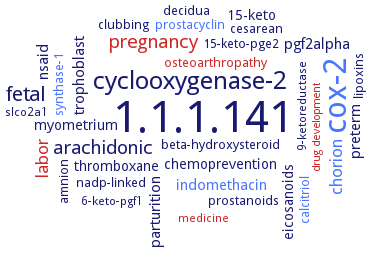1.1.1.141: 15-hydroxyprostaglandin dehydrogenase (NAD+)
This is an abbreviated version!
For detailed information about 15-hydroxyprostaglandin dehydrogenase (NAD+), go to the full flat file.

Word Map on EC 1.1.1.141 
-
1.1.1.141
-
cox-2
-
cyclooxygenase-2
-
fetal
-
arachidonic
-
pregnancy
-
chorion
-
labor
-
pgf2alpha
-
indomethacin
-
parturition
-
nsaid
-
trophoblast
-
preterm
-
myometrium
-
chemoprevention
-
15-keto
-
eicosanoids
-
thromboxane
-
prostanoids
-
decidua
-
synthase-1
-
nadp-linked
-
15-keto-pge2
-
clubbing
-
cesarean
-
osteoarthropathy
-
prostacyclin
-
amnion
-
beta-hydroxysteroid
-
lipoxins
-
calcitriol
-
9-ketoreductase
-
medicine
-
slco2a1
-
6-keto-pgf1
-
drug development
- 1.1.1.141
- cox-2
- cyclooxygenase-2
- fetal
-
arachidonic
- pregnancy
- chorion
- labor
-
pgf2alpha
- indomethacin
-
parturition
-
nsaid
- trophoblast
-
preterm
- myometrium
-
chemoprevention
-
15-keto
-
eicosanoids
-
thromboxane
-
prostanoids
- decidua
- synthase-1
-
nadp-linked
-
15-keto-pge2
-
clubbing
-
cesarean
- osteoarthropathy
- prostacyclin
- amnion
-
beta-hydroxysteroid
-
lipoxins
- calcitriol
-
9-ketoreductase
- medicine
-
slco2a1
-
6-keto-pgf1
- drug development
Reaction
Synonyms
11alpha,15-dihydroxy-9-oxoprost-13-enoate:NAD+ 15-oxidoreductase, 15-hydroxy prostaglandin dehydrogenase, 15-hydroxy-prostaglandin-dehydrogenase, 15-hydroxyprostaglandin dehydrogenase, 15-hydroxyprostaglandin-dehydrogenase, 15-hydroxyprostanoic dehydrogenase, 15-OH-PGDH, 15-PGDH, 15-prostaglandin dehydrogenase, dehydrogenase, 15-hydroxyprostaglandin, HPGD, NAD+ dependent 15-hydroxyprostaglandin dehydrogenase, NAD+ dependent PGDH, NAD+-15-hydroxy prostanoate oxidoreductase, NAD+-dependent 15-hydroxyprostaglandin dehydrogenase, NAD+-dependent 15-hydroxyprostaglandin dehydrogenase (type I), NAD+-dependent 15-PGDH, NAD+-linked 15-hydroxyprostaglandin dehydrogenase, NAD-dependent 15-hydroxyprostaglandin dehydrogenase, NAD-specific 15-hydroxyprostaglandin dehydrogenase, nicotinamide adenine dinucleotide-dependent 15-hydroxyprostaglandin dehydrogenase, PGDH, prostaglandin dehydrogenase


 results (
results ( results (
results ( top
top





